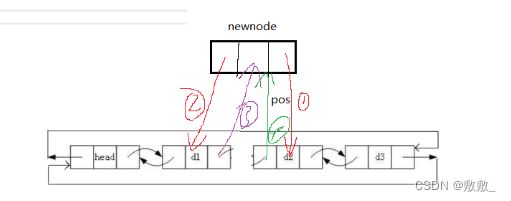【数据结构】——双链表(增删查改)
目录
前言:
一:双链表的定义
编辑 二:双向链表的实现
2.1:链表的构造
2.2:创建头节点
2.3:创建节点
2.4:链表的尾插
2.5:链表的打印
2.6:链表的尾删
2.7:链表的头插
2.8:链表的头删
2.9:链表的查找
2.10:在目标位置前面插入
2.11:删除目标位置结点
2.12:链表的销毁
总代码:
test.c
List.c
List.h
前言:
双链表的引入是因为单链表要访问某个结点的前驱结点时,只能从头开始遍历,访问后驱结点的复杂度为O(1),访问前驱结点的复杂度为O(n)。为了克服上述缺点,引入了双链表。
双链表的引进,对于链表的操作有了极大的遍历;
一:双链表的定义
链表由单向的链变成了双向链。
双向链表(double linked list)是在单链表的每个结点中再设置一个指向其前驱结点的指针域。
 二:双向链表的实现
二:双向链表的实现
2.1:链表的构造
包含了一个数据域,两个指针域(指向前后驱节点)
// 带头+双向+循环链表增删查改实现
typedef int LTDataType;
typedef struct ListNode
{
LTDataType data; //数据
struct ListNode* next; //下一个指针域
struct ListNode* prev; //上一个指针域
}ListNode;2.2:创建头节点
双向链表一般都是带头节点的,在链表中,带了头节点对于链表分割这一问题有了简单化;
动态开辟出一块空间,前后指针都指向自己;
//初始化链表头头节点
ListNode* ListInit()
{
ListNode* phead = (ListNode*)malloc(sizeof(ListNode));
assert(phead);
phead->data = -1;
phead->next = phead;
phead->prev = phead;
return phead;
}2.3:创建节点
这里置NULL,和单链表的置NULL,是一样的意思,对后续的操作提供便利;
// 创建返回链表的结点.
ListNode* ListCreate(LTDataType x)
{
ListNode* newnode = (ListNode*)malloc(sizeof(ListNode));
assert(newnode);
newnode->data = x;
newnode->next = NULL;
newnode->prev = NULL;
return newnode;
}2.4:链表的尾插
单链表的尾插还需要考虑是否存在第一个节点,这里直接插入即可;
注意操作顺序
// 双向链表尾插
void ListPushBack(ListNode* phead, LTDataType x)
{
assert(phead);
ListNode* newnode = ListCreate(x);
struct ListNode* tail = phead->prev;
// phead tail newnode
//newnode->prev = phead->prev;
//newnode->next = phead;
//phead->prev->next = newnode;
//phead->prev = newnode;
//注意前后顺序
newnode->prev = tail;
tail->next = newnode;
newnode->next = phead;
phead->prev = newnode;
}2.5:链表的打印
这里的关键就是从哪里开始?如何判断结束(因为是循环)?
我们可以从头结点的下一个开始打印,当遇到头结点即是结束;
// 双向链表打印
void ListPrint(ListNode* phead)
{
assert(phead);
struct ListNode* cur = phead->next;
printf("哨兵位<=>");
while (cur != phead)
{
printf("%d<=>", cur->data);
cur = cur->next;
}
printf("\n");
}2.6:链表的尾删
要多一个断言判断:如果只有一个头指针就不用操作了;
保存尾结点的前驱,释放尾结点即可
// 双向链表尾删
void ListPopBack(ListNode* phead)
{
assert(phead);
assert(phead->next != phead); //只有头指针不删
struct ListNode* cur = phead->prev;
struct ListNode* curPrev = cur->prev; //尾节点的上一个
phead->prev = curPrev;
curPrev->next = phead;
free(cur);
cur = NULL;
}2.7:链表的头插
和尾插操作相似,定义头节点的下一个结点,进行链接即可;
注意顺序;
// 双向链表头插
void ListPushFront(ListNode* phead, LTDataType x)
{
assert(phead);
ListNode* newnode = ListCreate(x);
struct ListNode* cur = phead->next;
newnode->next = cur;
cur->prev = newnode;
newnode->prev = phead;
phead->next = newnode;
}2.8:链表的头删
删除操作一般都需要判断一下是否只有头节点。判断双向链表的条件是:phead->next != phead;
// 双向链表头删
void ListPopFront(ListNode* phead)
{
assert(phead);
assert(phead->next != phead); //只有头指针不删
ListNode* cur = phead->next;
ListNode* next = cur->next;
phead->next = next;
next->prev = phead;
free(cur);
cur = NULL;
}2.9:链表的查找
找到该结点后,返回的是指针,而不是数据,返回该指针位置,方便后续操作
// 双向链表查找
ListNode* ListFind(ListNode* phead, LTDataType x)
{
assert(phead);
ListNode* cur = phead->next;
while (cur != phead)
{
if (cur->data == x)
return cur;
cur = cur->next;
}
return NULL;
}2.10:在目标位置前面插入
// 双向链表在pos的前面进行插入
void ListInsert(ListNode* pos, LTDataType x)
{
assert(pos); //检查pos位置是否有效
ListNode* newnode = ListCreate(x);
newnode->next = pos; //将newnode节点next prev 链接前后节点
newnode->prev = pos->prev;
pos->prev->next = newnode;
pos->prev = newnode;
}2.11:删除目标位置结点
// 双向链表删除pos位置的节点
void ListErase(ListNode* pos)
{
assert(pos);
ListNode* posPrev = pos->prev;
ListNode* next = pos->next;
posPrev->next = next;
next->prev = posPrev;
free(pos);
pos = NULL;
}2.12:链表的销毁
// 双向链表销毁
void ListDestory(ListNode* phead)
{
assert(phead);
ListNode* cur = phead->prev;
while (cur != phead) //将除了头结点的都销毁
{
ListNode* curPrev = cur->prev;
free(cur);
cur = curPrev;
}
free(phead); //再释放头结点
//phead = NULL;
}总代码:
test.c
#define _CRT_SECURE_NO_WARNINGS 1
#include"List.h"
void test1()
{
ListNode* plist = NULL;
plist = ListInit();
ListPushBack(plist, 1);
ListPushBack(plist, 2);
ListPushBack(plist, 3);
ListPushBack(plist, 4);
ListPrint(plist);
ListPopBack(plist);
ListPrint(plist);
ListPopBack(plist);
ListPrint(plist);
ListPopBack(plist);
ListPrint(plist);
ListPopBack(plist);
ListPrint(plist);
}
void test2()
{
ListNode* plist = NULL;
plist = ListInit();
ListPrint(plist);
//ͷ
ListPushFront(plist, 6);
ListPrint(plist);
//ͷɾ
ListPopFront(plist);
ListPrint(plist);
}
void test3()
{
ListNode* plist = NULL;
plist = ListInit();
ListPushBack(plist, 1);
ListPushBack(plist, 2);
ListPushBack(plist, 3);
ListPushBack(plist, 4);
ListPrint(plist);
//βɾ
ListPopBack(plist);
ListPopBack(plist);
ListPopBack(plist);
ListNode* pos = ListFind(plist,1);
ListInsert(pos, 666);
ListPrint(plist);
ListErase(pos);
ListPrint(plist);
ListDestory(plist);
}
int main()
{
//test1();
//test2();
test3();
return 0;
}List.c
#define _CRT_SECURE_NO_WARNINGS 1
#include"List.h"
//初始化链表头头节点
ListNode* ListInit()
{
ListNode* phead = (ListNode*)malloc(sizeof(ListNode));
assert(phead);
phead->data = -1;
phead->next = phead;
phead->prev = phead;
return phead;
}
// 创建返回链表的头结点.
ListNode* ListCreate(LTDataType x)
{
ListNode* newnode = (ListNode*)malloc(sizeof(ListNode));
assert(newnode);
newnode->data = x;
newnode->next = NULL;
newnode->prev = NULL;
return newnode;
}
// 双向链表尾插
void ListPushBack(ListNode* phead, LTDataType x)
{
assert(phead);
ListNode* newnode = ListCreate(x);
struct ListNode* tail = phead->prev;
// phead tail newnode
//newnode->prev = phead->prev;
//newnode->next = phead;
//phead->prev->next = newnode;
//phead->prev = newnode;
//注意前后顺序
newnode->prev = tail;
tail->next = newnode;
newnode->next = phead;
phead->prev = newnode;
}
// 双向链表打印
void ListPrint(ListNode* phead)
{
assert(phead);
struct ListNode* cur = phead->next;
printf("哨兵位<=>");
while (cur != phead)
{
printf("%d<=>", cur->data);
cur = cur->next;
}
printf("\n");
}
// 双向链表尾删
void ListPopBack(ListNode* phead)
{
assert(phead);
assert(phead->next != phead); //只有头指针不删
struct ListNode* cur = phead->prev;
struct ListNode* curPrev = cur->prev; //尾节点的上一个
phead->prev = curPrev;
curPrev->next = phead;
free(cur);
cur = NULL;
}
// 双向链表头插
void ListPushFront(ListNode* phead, LTDataType x)
{
assert(phead);
ListNode* newnode = ListCreate(x);
struct ListNode* cur = phead->next;
newnode->next = cur;
cur->prev = newnode;
newnode->prev = phead;
phead->next = newnode;
}
// 双向链表头删
void ListPopFront(ListNode* phead)
{
assert(phead);
assert(phead->next != phead); //只有头指针不删
ListNode* cur = phead->next;
ListNode* next = cur->next;
phead->next = next;
next->prev = phead;
free(cur);
cur = NULL;
}
// 双向链表查找
ListNode* ListFind(ListNode* phead, LTDataType x)
{
assert(phead);
ListNode* cur = phead->next;
while (cur != phead)
{
if (cur->data == x)
return cur;
cur = cur->next;
}
return NULL;
}
// 双向链表在pos的前面进行插入
void ListInsert(ListNode* pos, LTDataType x)
{
assert(pos); //检查pos位置是否有效
ListNode* newnode = ListCreate(x);
newnode->next = pos; //将newnode节点next prev 链接前后节点
newnode->prev = pos->prev;
pos->prev->next = newnode;
pos->prev = newnode;
}
// 双向链表删除pos位置的节点
void ListErase(ListNode* pos)
{
assert(pos);
ListNode* posPrev = pos->prev;
ListNode* next = pos->next;
posPrev->next = next;
next->prev = posPrev;
free(pos);
pos = NULL;
}
// 双向链表销毁
void ListDestory(ListNode* phead)
{
assert(phead);
ListNode* cur = phead->prev;
while (cur != phead) //将除了头节点的都销毁
{
ListNode* curPrev = cur->prev;
free(cur);
cur = curPrev;
}
free(phead);
//phead = NULL;
}List.h
#pragma once
#include
#include
#include
// 带头+双向+循环链表增删查改实现
typedef int LTDataType;
typedef struct ListNode
{
LTDataType data; //数据
struct ListNode* next; //下一个指针域
struct ListNode* prev; //上一个指针域
}ListNode;
// 创建返回链表的头结点.
ListNode* ListCreate(LTDataType x);
//初始化链表头头节点
ListNode* ListInit();
// 双向链表尾插
void ListPushBack(ListNode* pHead, LTDataType x);
// 双向链表打印
void ListPrint(ListNode* pHead);
// 双向链表尾删
void ListPopBack(ListNode* pHead);
// 双向链表头插
void ListPushFront(ListNode* pHead, LTDataType x);
// 双向链表头删
void ListPopFront(ListNode* pHead);
// 双向链表查找
ListNode* ListFind(ListNode* pHead, LTDataType x);
// 双向链表在pos的前面进行插入
void ListInsert(ListNode* pos, LTDataType x);
// 双向链表删除pos位置的节点
void ListErase(ListNode* pos);
// 双向链表销毁
void ListDestory(ListNode* pHead); 以上就是我对【数据结构|双向链表|增删改查】的介绍,不足之处,还望指点。








